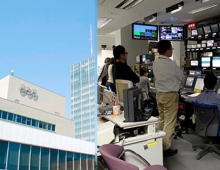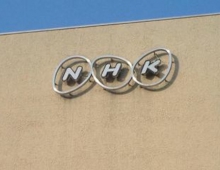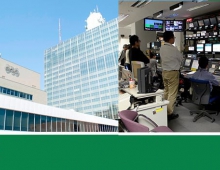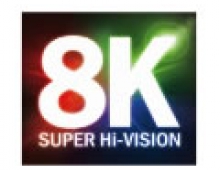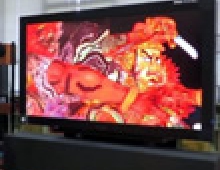
Super Hi-Vision Technology to Reach Comsumers in 2020
Japan Broadcasting Corporation (NHK) presented the future of digital imaging technologies and broadcasting at the IBC 2008 show in Amsterdam.
Developed by NHK and JVC, Super Hi-Vision Technology (SHV)
promises to offer ultrahigh-definition images at a resolution of 7680 x 4320 (32K), which is sixteen higher than the current HDTV systems.
Conceived in the late '90's and first promised for 2025, the 8k format Super Hi-Vision is now on the road to becoming a consumer service by 2020, according to NHK. NHK's project leader, Dr Keiichi Kubota, heralded two big differences since Super Hi-Vision first wowed visitors to IBC in 2002.
"NHK's goal is for Super Hi-Vision to be enjoyed in every home," said Kubota. " It is our responsibility to show broadcasters and network operators that it is not just a dream but a real future television system."
Kubota believes public attended applications will be possible before a full production system is possible in 2020.
The technology has been demonstrated at IBC before but this week a consortium of broadcasters headed by NHK of Japan, RAI of Italy, the BBC and the EBU delivered the world's first live satellite international broadcast.
"I think Dr Kubota is probably right about the 12-year programme, because although the transmission demo shows NHK has come a long way we still have prototype cameras and projector systems," Kubota added. "And of course the big thing to wait for is the full 8k resolution of domestic displays."
SHV is a staggering 16 times greater than HDTV (7680 x 4320 pixels or 33 megapixels), devised by NHK - which famously initiated HD as far back as 1969. It is now one of the activities of the Broadcast Technology Futures group (BTF), an Alliance of leading broadcast research and development facilities and bodies including the EBU that aims to bring the technology away from the drawing board and into public test.
According to John Zubrzycki, Principal Technologist, Beyond HD at BBC Research & Innovation, "The IBC demonstrations are a crystallisation of what all the partner labs have been working on together. We want to evaluate how well all the different elements work in practice. In particular one demonstration will help prove that a broadcaster can connect with live cameras from any part of the world and on the satellite side we aim to demonstrate that SHV has the potential for broadcast to the home."
In the series of demonstrations - which ran throughout the IBC2008 convention and are open to all visitors - 22 minutes of unique content shot in Japan were mixed with live pictures from a camera located in central London, operated by SIS Outside Broadcasts. This live feed was compressed in MPEG-2 and delivered over an ultra-broadband fibre, provided by Siemens in London and by Cable&Wireless for the international hop to Amsterdam.
In the year since it was last demonstrated, NHK has developed an 8K image sensor that can shoot an entire SHV screen (rather than using pairs of half-pixel offset 4K sensors in previous prototypes).
Capable of capturing data at 4000 lines per frame, the camera will be operated in conjunction with SIS OB who will treat the event like any normal live production. NHK, which has a purpose-built 45-inch screen for monitoring has also developed a 22.2 channel surround sound specification that features 10 speakers at ear level, 9 above, 3 below, plus another 2 for effects. The whole setup comes at the cost of vastly higher bandwidth - one minute of uncompressed footage consumes 194GB.
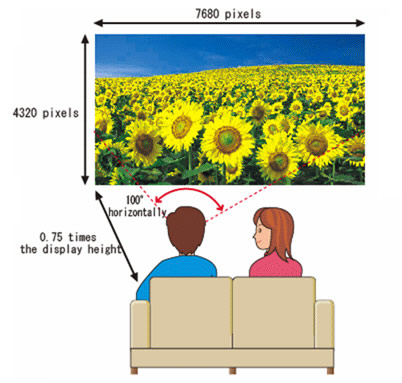
Content was also played into the IBC demonstration from a server in Torino, delivered over two full satellite transponders provided by Eutelsat. Back on the NHK theatre, a similar display with a second demonstration showing SHV content coded using the BBC's open source Dirac algorithm.
"The native bitrate from the camera is 8 bit at 36 Gigabit a second so we need to get it down to something useable in a broadcast infrastructure. Dirac is one option for this since it also provides a more graceful compression than MPEG. The first target though is to get down to 10 Gigabit which is a useful broadcast standard."
The biggest challenge says Zubrzycki will be achieving an error free transmission and maintaining the signal when transported across a series of networks.
"There are still a lot of improvements to be had with video coding, and that's really the core of our research with NHK. We need to improve on the quality and reduce the bitrate further to make it more efficient for satellite broadcasting," Zubrzycki said.
"The next step is that we'd like to see Dirac hardware and get away from software coding. There will be further developments towards making contribution links more practical for doing outside events," Zubrzycki added.
In addition, NHK hopes that devices capable of dispaying the 8K resolution images will be available on the market by 2020.
Conceived in the late '90's and first promised for 2025, the 8k format Super Hi-Vision is now on the road to becoming a consumer service by 2020, according to NHK. NHK's project leader, Dr Keiichi Kubota, heralded two big differences since Super Hi-Vision first wowed visitors to IBC in 2002.
"NHK's goal is for Super Hi-Vision to be enjoyed in every home," said Kubota. " It is our responsibility to show broadcasters and network operators that it is not just a dream but a real future television system."
Kubota believes public attended applications will be possible before a full production system is possible in 2020.
The technology has been demonstrated at IBC before but this week a consortium of broadcasters headed by NHK of Japan, RAI of Italy, the BBC and the EBU delivered the world's first live satellite international broadcast.
"I think Dr Kubota is probably right about the 12-year programme, because although the transmission demo shows NHK has come a long way we still have prototype cameras and projector systems," Kubota added. "And of course the big thing to wait for is the full 8k resolution of domestic displays."
SHV is a staggering 16 times greater than HDTV (7680 x 4320 pixels or 33 megapixels), devised by NHK - which famously initiated HD as far back as 1969. It is now one of the activities of the Broadcast Technology Futures group (BTF), an Alliance of leading broadcast research and development facilities and bodies including the EBU that aims to bring the technology away from the drawing board and into public test.
According to John Zubrzycki, Principal Technologist, Beyond HD at BBC Research & Innovation, "The IBC demonstrations are a crystallisation of what all the partner labs have been working on together. We want to evaluate how well all the different elements work in practice. In particular one demonstration will help prove that a broadcaster can connect with live cameras from any part of the world and on the satellite side we aim to demonstrate that SHV has the potential for broadcast to the home."
In the series of demonstrations - which ran throughout the IBC2008 convention and are open to all visitors - 22 minutes of unique content shot in Japan were mixed with live pictures from a camera located in central London, operated by SIS Outside Broadcasts. This live feed was compressed in MPEG-2 and delivered over an ultra-broadband fibre, provided by Siemens in London and by Cable&Wireless for the international hop to Amsterdam.
In the year since it was last demonstrated, NHK has developed an 8K image sensor that can shoot an entire SHV screen (rather than using pairs of half-pixel offset 4K sensors in previous prototypes).
Capable of capturing data at 4000 lines per frame, the camera will be operated in conjunction with SIS OB who will treat the event like any normal live production. NHK, which has a purpose-built 45-inch screen for monitoring has also developed a 22.2 channel surround sound specification that features 10 speakers at ear level, 9 above, 3 below, plus another 2 for effects. The whole setup comes at the cost of vastly higher bandwidth - one minute of uncompressed footage consumes 194GB.

Content was also played into the IBC demonstration from a server in Torino, delivered over two full satellite transponders provided by Eutelsat. Back on the NHK theatre, a similar display with a second demonstration showing SHV content coded using the BBC's open source Dirac algorithm.
"The native bitrate from the camera is 8 bit at 36 Gigabit a second so we need to get it down to something useable in a broadcast infrastructure. Dirac is one option for this since it also provides a more graceful compression than MPEG. The first target though is to get down to 10 Gigabit which is a useful broadcast standard."
The biggest challenge says Zubrzycki will be achieving an error free transmission and maintaining the signal when transported across a series of networks.
"There are still a lot of improvements to be had with video coding, and that's really the core of our research with NHK. We need to improve on the quality and reduce the bitrate further to make it more efficient for satellite broadcasting," Zubrzycki said.
"The next step is that we'd like to see Dirac hardware and get away from software coding. There will be further developments towards making contribution links more practical for doing outside events," Zubrzycki added.
In addition, NHK hopes that devices capable of dispaying the 8K resolution images will be available on the market by 2020.

